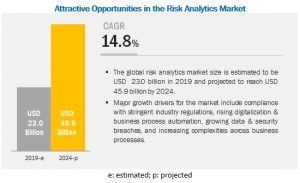As any company leader knows, there isn’t a business that doesn’t face some risks. If a company wants to get ahead of the competition, grow steadily, and essentially stay in business, it’ll have to face all sorts of them. Doing so is the only way to find new opportunities, which are key to any brand.
There a lot of risks but they can basically be divided into two traditional categories. There are operational risks, which are the common issues found in everyday processes. These refer to everything ranging from equipment breaking down to data breaches. And then there are strategic risks, which are harder to anticipate and manage, as they are broader and can have a deeper impact. These risks include changes in the market and in consumer needs.
Today, businesses have a lot of methods and techniques to deal with both types of risks. However, how some companies are tackling their operational risks can serve as an example to develop more sophisticated ways to manage strategic risks. Basically, we’re talking about the use of machine learning algorithms to anticipate potential operational issues.
Companies use such solutions to schedule preventive maintenance for equipment, detect suspicious activities in networks, improve supply chain management, and even to identify employee attrition. Anticipating potential problems and taking corrective measures ahead of time is a fantastic way to avoid costly issues and keep processes going.
All of that is possible thanks to the use of data science. Machine learning algorithms take a look at large data sets and analyze them in search of patterns that suggest potential problems. After that, they can take action to prevent the issue from happening or it can send a warning for a human to take the necessary corrective steps. Incredibly enough, the same approach can be used when dealing with elusive strategic risks.

Source: Markets and Markets
The power of data when dealing with strategic risks
Traditionally, executives have dealt with strategic risks by using their own experience and their gut to make decisions. Thus, they relied on what they already knew and what their instincts told them to guess, everything from potential changes in consumer behaviors and market shifts to potentially disruptive new technologies.
Naturally, this made for a far-from-ideal technique. Depending on an executive’s guts to define the future of a company is a strategy that’s prone to be plagued with failures. Past experiences can serve up to a point but reality doesn’t necessarily adhere to how things used to be. Executives might have blind faith about an upcoming technology only for it to fall short of their expectations. They may even be biased because of their own aspirations and motivations.
That’s why data science can be so helpful in this field. Today, companies can amass large data sets from a variety of sources. They can use sales reports, website analytics, social network interactions, news articles, stock marketing info, and many other things to build a database. That’s the main resource machine learning algorithms need to make their analysis and help in making predictions regarding potential strategic risks.
There are several ways in which these algorithms can be used. For instance, data science can use stock market info combined with sales reports, economic factors, seasonal behaviors of the customer base, and other metrics, to anticipate potential fluctuations in the demand for certain items. Such insight can prove to be very beneficial for executives, as they can foresee how the fluctuation of the demand will impact the supply chain, the company’s finances, and the clients’ requests.
There are other uses for data science in strategic risk management. For instance, machine learning algorithms can be trained to be on the look for disruptive new technologies or emergent startups that can become decisive in a particular field. In that way, data science could help companies to identify the technologies that could truly make a difference in the mid and long term, especially for early adopters. Additionally, analyzing data could detect the rise of new companies and products and the consumer’s feelings around them. This could provide insights into new business opportunities and identify new consumer interests.
Naturally, data science isn’t complete without the right data scientists. These are the experts capable of understanding the patterns detected by the algorithms and making sense out of them. This is especially true for strategic risk management, as data science can only point out to certain phenomena happening in the market that needs the proper interpretation in a specific context.
In other words, companies looking to use data science for strategic risk management need to understand that implementing this technology isn’t comparable to using magic. There’s still work to be done by experts to make sense out of the data. Said experts need to have a solid understanding of a number of things, including the company itself, the market, and the data science world. They will act as the interpreters for executives to make more informed decisions, so they are as essential as the algorithms used for the analysis.
Some final words
Risk management teams can deeply benefit from the use of data science. Mirroring what’s already happening with operational risks, companies can take advantage of this cutting-edge technology to replace the gut-based decisions used in the past to deal with strategic risks. By basing decisions on actual data, executives can limit the uncertainty and reduce the potential downsides associated with strategic risks.
Of course, there will be areas and industries in which data science will be more useful and telling. That mainly depends on the type of data available and how it’s gathered. These issues can be overcome, however, through the creative use of machine learning algorithms to collect and evaluate the data. This calls for a systematic approach to data science when applied to risk management that might take significant effort.
Yet, investing enough on developing that approach and its associated processes can be very rewarding, as using data science can provide deep insights through the quantification of the unavoidable risks present in all businesses and the analysis of the opportunities that stem from them.







